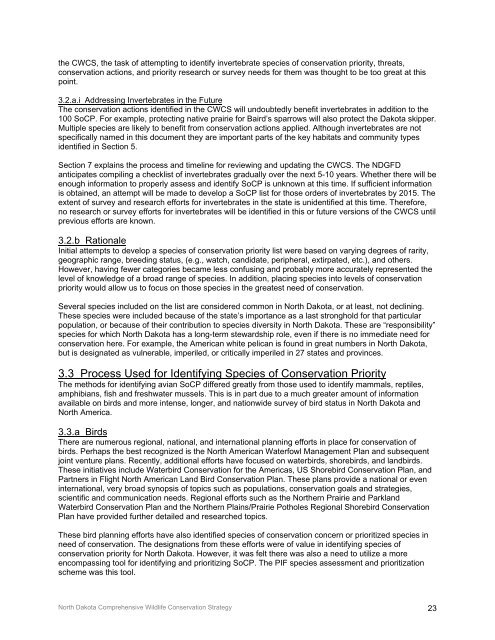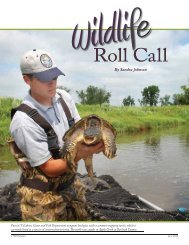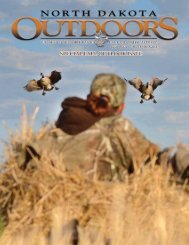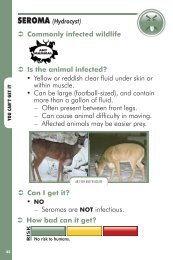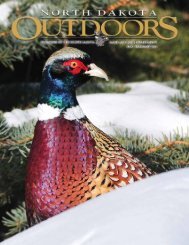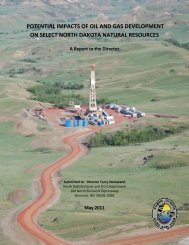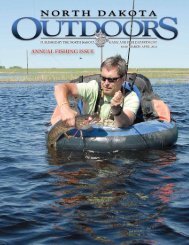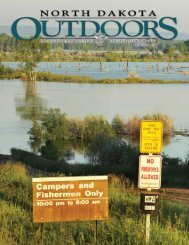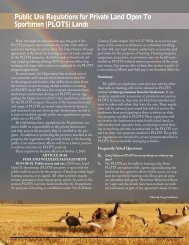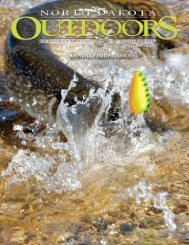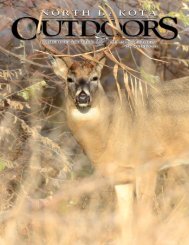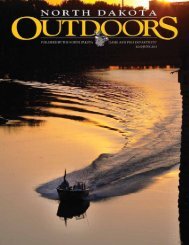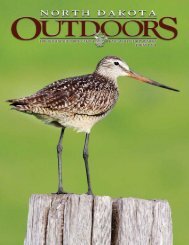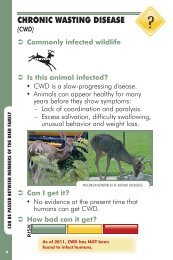North Dakota Wildlife Action Plan - North Dakota Game and Fish ...
North Dakota Wildlife Action Plan - North Dakota Game and Fish ...
North Dakota Wildlife Action Plan - North Dakota Game and Fish ...
Create successful ePaper yourself
Turn your PDF publications into a flip-book with our unique Google optimized e-Paper software.
the CWCS, the task of attempting to identify invertebrate species of conservation priority, threats,<br />
conservation actions, <strong>and</strong> priority research or survey needs for them was thought to be too great at this<br />
point.<br />
3.2.a.i Addressing Invertebrates in the Future<br />
The conservation actions identified in the CWCS will undoubtedly benefit invertebrates in addition to the<br />
100 SoCP. For example, protecting native prairie for Baird’s sparrows will also protect the <strong>Dakota</strong> skipper.<br />
Multiple species are likely to benefit from conservation actions applied. Although invertebrates are not<br />
specifically named in this document they are important parts of the key habitats <strong>and</strong> community types<br />
identified in Section 5.<br />
Section 7 explains the process <strong>and</strong> timeline for reviewing <strong>and</strong> updating the CWCS. The NDGFD<br />
anticipates compiling a checklist of invertebrates gradually over the next 5-10 years. Whether there will be<br />
enough information to properly assess <strong>and</strong> identify SoCP is unknown at this time. If sufficient information<br />
is obtained, an attempt will be made to develop a SoCP list for those orders of invertebrates by 2015. The<br />
extent of survey <strong>and</strong> research efforts for invertebrates in the state is unidentified at this time. Therefore,<br />
no research or survey efforts for invertebrates will be identified in this or future versions of the CWCS until<br />
previous efforts are known.<br />
3.2.b Rationale<br />
Initial attempts to develop a species of conservation priority list were based on varying degrees of rarity,<br />
geographic range, breeding status, (e.g., watch, c<strong>and</strong>idate, peripheral, extirpated, etc.), <strong>and</strong> others.<br />
However, having fewer categories became less confusing <strong>and</strong> probably more accurately represented the<br />
level of knowledge of a broad range of species. In addition, placing species into levels of conservation<br />
priority would allow us to focus on those species in the greatest need of conservation.<br />
Several species included on the list are considered common in <strong>North</strong> <strong>Dakota</strong>, or at least, not declining.<br />
These species were included because of the state’s importance as a last stronghold for that particular<br />
population, or because of their contribution to species diversity in <strong>North</strong> <strong>Dakota</strong>. These are “responsibility”<br />
species for which <strong>North</strong> <strong>Dakota</strong> has a long-term stewardship role, even if there is no immediate need for<br />
conservation here. For example, the American white pelican is found in great numbers in <strong>North</strong> <strong>Dakota</strong>,<br />
but is designated as vulnerable, imperiled, or critically imperiled in 27 states <strong>and</strong> provinces.<br />
3.3 Process Used for Identifying Species of Conservation Priority<br />
The methods for identifying avian SoCP differed greatly from those used to identify mammals, reptiles,<br />
amphibians, fish <strong>and</strong> freshwater mussels. This is in part due to a much greater amount of information<br />
available on birds <strong>and</strong> more intense, longer, <strong>and</strong> nationwide survey of bird status in <strong>North</strong> <strong>Dakota</strong> <strong>and</strong><br />
<strong>North</strong> America.<br />
3.3.a Birds<br />
There are numerous regional, national, <strong>and</strong> international planning efforts in place for conservation of<br />
birds. Perhaps the best recognized is the <strong>North</strong> American Waterfowl Management <strong>Plan</strong> <strong>and</strong> subsequent<br />
joint venture plans. Recently, additional efforts have focused on waterbirds, shorebirds, <strong>and</strong> l<strong>and</strong>birds.<br />
These initiatives include Waterbird Conservation for the Americas, US Shorebird Conservation <strong>Plan</strong>, <strong>and</strong><br />
Partners in Flight <strong>North</strong> American L<strong>and</strong> Bird Conservation <strong>Plan</strong>. These plans provide a national or even<br />
international, very broad synopsis of topics such as populations, conservation goals <strong>and</strong> strategies,<br />
scientific <strong>and</strong> communication needs. Regional efforts such as the <strong>North</strong>ern Prairie <strong>and</strong> Parkl<strong>and</strong><br />
Waterbird Conservation <strong>Plan</strong> <strong>and</strong> the <strong>North</strong>ern Plains/Prairie Potholes Regional Shorebird Conservation<br />
<strong>Plan</strong> have provided further detailed <strong>and</strong> researched topics.<br />
These bird planning efforts have also identified species of conservation concern or prioritized species in<br />
need of conservation. The designations from these efforts were of value in identifying species of<br />
conservation priority for <strong>North</strong> <strong>Dakota</strong>. However, it was felt there was also a need to utilize a more<br />
encompassing tool for identifying <strong>and</strong> prioritizing SoCP. The PIF species assessment <strong>and</strong> prioritization<br />
scheme was this tool.<br />
<strong>North</strong> <strong>Dakota</strong> Comprehensive <strong>Wildlife</strong> Conservation Strategy 23


